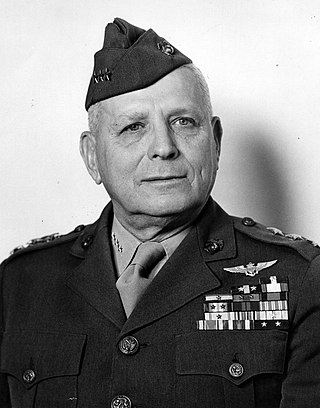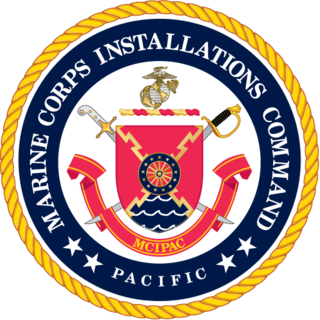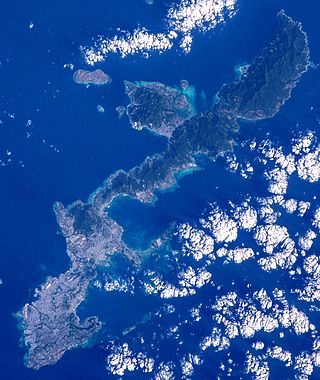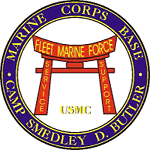
The Battle of Okinawa, codenamed Operation Iceberg, was a major battle of the Pacific War fought on the island of Okinawa by United States Army and United States Marine Corps forces against the Imperial Japanese Army. The initial invasion of Okinawa on 1 April 1945 was the largest amphibious assault in the Pacific Theater of World War II. The Kerama Islands surrounding Okinawa were preemptively captured on 26 March by the 77th Infantry Division. The 82-day battle lasted from 1 April until 22 June 1945. After a long campaign of island hopping, the Allies were planning to use Kadena Air Base on the large island of Okinawa as a base for Operation Downfall, the planned invasion of the Japanese home islands, 340 mi (550 km) away.

Okinawa Prefecture is the southernmost and westernmost prefecture of Japan. It has a population of 1,457,162 and a geographic area of 2,281 km2.

Simon Bolivar Buckner Jr. was a lieutenant general in the United States Army during World War II who served in the Pacific Theater. As commanding general of Alaska Defense Command, Buckner commanded American-Canadian forces in the Aleutian Islands campaign, including the Battle of Attu and the Kiska Expedition. Following that assignment, he was promoted to command the Tenth Army, which conducted the amphibious invasion of the Japanese island of Okinawa in 1945. He was killed during the closing days of the Battle of Okinawa by enemy artillery fire, making him one of the highest-ranking United States military officers lost to enemy fire during World War II.

The United States Forces Japan (USFJ) is a subordinate unified command of the United States Indo-Pacific Command. It was activated at Fuchū Air Station in Tokyo, Japan, on 1 July 1957 to replace the Far East Command. USFJ is headquartered at Yokota Air Base in Tokyo and is commanded by the Commander, US Forces Japan who is also commander of the Fifth Air Force.

The Tenth United States Army was the last army level command established during the Pacific War during World War II, and included divisions from both the U.S. Army and the U.S. Marine Corps.

Roy Stanley Geiger was a United States Marine Corps four-star general who served in World War I and World War II. In World War II, he became the first Marine Corps general to lead a field army.

Marine Corps Air Station Futenma or MCAS FutenmaA is a United States Marine Corps base located in Ginowan, Okinawa, Japan, 5 NM northeastB of Naha, on the island of Okinawa. It is home to approximately 3,000 Marines of the 1st Marine Aircraft Wing and other units, and has been a U.S. military airbase since the defeat of the Japanese Imperial Army in the Battle of Okinawa in 1945. Marine Corps pilots and aircrew are assigned to the base for training and providing air support to other land and sea-based Marines in Okinawa and throughout the Asia-Pacific region. MCAS Futenma is part of the Marine Corps Installations Pacific command.

Camp Foster, formerly known as Camp Zukeran, is a United States Marine Corps camp located in Ginowan City with portions overlapping into Okinawa City, Chatan town and Kitanakagusuku village in the Japanese prefecture of Okinawa Island. It is part of the Marine Corps Base Camp Smedley D. Butler complex.

Camp Courtney is a U.S. Marine Base located in Uruma City, Okinawa Prefecture, Japan. It is part of the larger Marine Corps Base Camp Smedley D. Butler and home to the III Marine Expeditionary Force, 3rd Marine Division, and 3d MEB Headquarters. It is named after Major Henry A. Courtney, Jr., who was killed in action in the Battle of Okinawa. Camp Courtney covers 1.339 square kilometres (0.517 sq mi) in the Konbu, Tengan, and Uken districts of Uruma.

Camp Kinser is a United States Marine Corps logistics base in Okinawa, Japan.

The 4th Marine Regiment is an infantry regiment of the United States Marine Corps. Based at Camp Schwab in Okinawa, Japan, it is part of the 3rd Marine Division of the III Marine Expeditionary Force.

Camp Hansen is a United States Marine Corps base located in Okinawa, Japan. The camp is situated in the town of Kin, near the northern shore of Kin Bay, and is the second-northernmost major installation on Okinawa, with Camp Schwab to the north. The camp houses approximately 6,000 Marines nowadays, and is part of Marine Corps Base Camp Butler, which itself is not a physical base and comprises all Marine Corps installations on Okinawa.

The 3rd Marine Logistics Group is the Logistics Combat Element (LCE) for III Marine Expeditionary Force currently headquartered on Camp Kinser, Marine Corps Base Smedley D. Butler, Okinawa, Japan. 3rd MLG provides combat service support (CSS) to III MEF units above the organic capability. CSS is the essential capabilities, functions, activities, and tasks necessary to sustain all elements of operating forces in theater at all levels of war. Combat service support includes, but is not limited, to supply, maintenance, transportation, general engineering, health services, and other services required by aviation and ground combat forces to permit those units to accomplish their missions.

The United States Marine Corps is organized within the Department of the Navy, which is led by the Secretary of the Navy (SECNAV). The most senior Marine commissioned officer is the Commandant of the Marine Corps, responsible for organizing, recruiting, training, and equipping the Marine Corps so that it is ready for operation under the command of the unified combatant commanders. The Marine Corps is organized into four principal subdivisions: Headquarters Marine Corps, the Operating Forces, the Supporting Establishment, and the Marine Forces Reserve.

John Kerry Davis, also known as J.K. Davis, was a United States Marine Corps four-star general. Davis, a Vietnam War veteran and naval aviator, served as the Commanding General of the 3rd Marine Aircraft Wing (1977–1978) and the 1st Marine Aircraft Wing (1978-1978). His final assignment was as the Assistant Commandant of the Marine Corps from July 1, 1983, to June 1, 1986.

Yontan Airfield is a former military airfield located near Yomitan Village on the west coast of Okinawa. It was closed in July 1996 and turned over to the Japanese government in December 2006. Today it is home to the Yomitan Village Office and community complex, including baseball fields, running tracks, and community facilities.

The Marine Corps Installations Pacific (MCIPAC) is the single, regional authority for accountability of regional installation management resources and services within the Pacific area of operations. MCIPAC was established to increase regional installation management effectiveness. MCIPAC implements policies, develops regional strategies and plans, prioritizes resources, and provides services, direction, and oversight to all Marine Corps installations in Japan, the Republic of Korea, and Hawaii.

The Marine Corps Installations Command (MCICOM) was created on October 1, 2011 to oversee U.S. Marine Corps installations through direct oversight, policy creation and coordination, and resource prioritization. MCICOM is currently commanded by Major General David W. Maxwell.

Naval Base Okinawa, now Naval Facility Okinawa, is a number of bases built after the Battle of Okinawa by United States Navy on Okinawa Island, Japan. The naval bases were built to support the landings on Okinawa on April 1, 1945, and the troops fighting on Okinawa. The Navy repaired and did expansion of the airfields on Okinawa. United States Navy Seabees built or repaired the facilities on the island. The bases on Okinawa put the United States Armed Forces only 350 miles from Japan's home islands. Most facilities closed after the war, but some are still in use today by all branches of the United States Armed Forces.





















